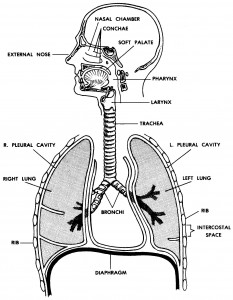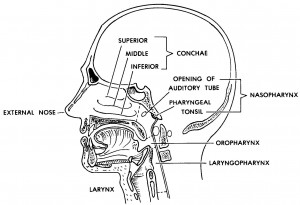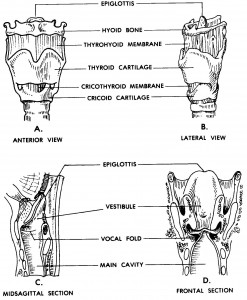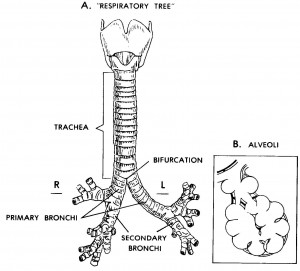Basic Human Anatomy
Lesson 7: Respiratory System
Welcome to Lesson 7 of the Basic Human Anatomy Course. Today, we’ll be studying the Human Respiratory System.
I have 4 goals for you in this lesson:
- Define respiration, external respiration, internal respiration and breathing.
- Identify the main subdivisions of the respiratory system and their functions.
- Describe the external nose, nasal chambers, pharynx, larynx, trachea, bronchi, alveoli, lungs, and pleural cavities.
- Describe breathing and breathing mechanisms.
INTRODUCTION
- Respiration. Respiration is the exchange of gases between the atmosphere and the cells of the body. It is a physiological process. There are two types of respiration–external and internal. External respiration is the exchange of gases between the air in the lungs and blood. Internal respiration is the exchange of gases between the blood and the individual cells of the body.
- Breathing. Breathing is the process that moves air into and out of the lungs. It is a mechanical process. There are two types of breathing in humans—costal (thoracic) and diaphragmatic (abdominal). In costal breathing, the major structure causing the movement of the air is the rib cage. In diaphragmatic breathing, interaction between the diaphragm and the abdominal wall causes the air to move into and out of the lungs.
COMPONENTS AND SUBDIVISIONS OF THE HUMAN RESPIRATORY SYSTEM
See figure 7-1 for an illustration of the human respiratory system.
- Components. The components of the human respiratory system consist of air passageways and two lungs. Air moves from the outside of the body into tiny sacs in the lungs called alveoli (pronounced al-VE-oh-lie).
- Main Subdivisions. The main subdivisions of the respiratory system may be identified by their relationship to the voice box or larynx. Thus, the main subdivisions are as listed in table 7-1.

Figure 7-1. The human respiratory system.
|
SUBDIVISION |
FUNCTION |
|
SUPRALARYNGEAL STRUCTURES (su-prah-lah-RIN-je-al) |
Cleanse, warm, moisten, and test inflowing air |
|
LARYNX (voice box) (LARE-inks) |
Controls the volume of inflowing air; produces selected pitch(vibration frequency) in the moving column of air |
|
INFRALARYNGEAL STRUCTURES (in-frah-lah-RIN-je-al) |
Distribute air to the alveoli of the lung where the actual external respiration takes place |
Table 7-1. The main subdivisions of the respiratory system.
SUPRALARYNGEAL STRUCTURES

Figure 7-2. Supralaryngeal structures.
- External Nose. The external nose is the portion projecting from the face. It is supported primarily by cartilages. It has a midline divider called the nasal septum, which extends from the internal nose. Paired openings (nostrils) lead to paired paces (vestibules). Guard hairs in the nostrils filter inflowing air.
- Nasal Chambers (Internal Nose). Behind each vestibule of the external nose is a nasal chamber. The two nasal chambers together form the internal nose. These chambers too are separated by the nasal septum.
-
- Mucoperiosteum. The walls of the nasal chambers are lined with a thick mucous-type membrane known as the mucoperiosteum. It has a ciliated epithelial surface and a rich blood supply, which provides warmth and moisture. At times, it may become quite swollen.
CILIATED = provided with cilia (hairlike projections which move fluids to the rear)
-
- Conchae. The lateral wall of each chamber has three scroll- like extensions into the nasal chamber which help to increase the surface area exposed to the inflowing air. These scroll-like extensions are known as conchae.
CONCHA (pronounced KON-kah) = sea shell CONCHA (singular), CONCHAE (plural)
-
- Olfactory epithelium. The sense of smell is due to special nerve endings located in the upper areas of the nasal chambers. The epithelium containing the sensory endings is known as the olfactory epithelium.
-
- Paranasal sinuses. There are air “cells” or cavities in the skull known as paranasal sinuses. The paranasal sinuses are connected with the nasal
chambers and are lined with the same ciliated mucoperiosteum. Thus, these sinuses are extensions of the nasal chambers into the skull bones. For this reason, they are known as paranasal sinuses.
- Pharynx. The pharynx (FAIR-inks) is the common posterior space for the respiratory and digestive systems.
-
- Nasopharynx. That portion of the pharynx specifically related to the respiratory system is the nasopharynx. It is the portion of the pharynx above the soft palate. The two posterior openings (nares) of the nasal chambers lead into the single space of the nasopharynx. The auditory (eustachian) tubes also open into the nasopharynx. The auditory tubes connect the nasopharynx with the middle ears (to equalize the pressure between the outside and inside of the eardrum). Lying in the upper posterior wall of the nasopharynx are the pharyngeal tonsils (adenoids). The soft palate floor of the nasopharynx is a trapdoor which closes off the upper respiratory passageways during swallowing.
-
- Oropharynx. The portion of the pharynx closely related to the digestive system is the oropharynx. It is the portion of the pharynx below the soft palate and above the upper edge of the epiglottis. (The epiglottis is the flap that prevents food from entering the larynx (discussed below) during swallowing.)
-
- Laryngopharynx. That portion of the pharynx which is common to the respiratory and digestive systems is the laryngopharynx. It is the portion of the pharynx below the upper edge of the epiglottis. Thus, the digestive and respiratory systems lead into it from above and lead off from it below.
LARYNX
The larynx, also called the Adam’s apple or voice box, connects the pharynx with the trachea. The larynx, located in the anterior neck region, has a box-like shape. See figure 7-3 for an illustration. Since the voice box of the male becomes larger and heavier during puberty, the voice deepens. The adult male’s voice box tends to be located lower in the neck; in the female, the larynx remains higher and smaller and the voice is of a higher pitch.
- Parts and Spaces. The larynx has a vestibule (“entrance hallway”) which can be covered over by the epiglottis. The glottis itself is the hole between the vocal cords. Through the glottis, air passes from the vestibule into the main chamber of the larynx (below the cords) and then into the trachea. The skeleton of the larynx is made up of a series of cartilages.
- Muscles. The larynx serves two functions and there are two sets of muscles– one for each function.
-
- One set controls the size of the glottis. Thus, it regulates the volume of air passing through the trachea.
-
- The other set controls the tension of the vocal cords. Thus, it produces vibrations of selected frequencies (variations in pitch) of the moving air to be used in the process of speaking.

Figure 7-3. The larynx.
INFRALARYNGEAL STRUCTURES
- Trachea and Bronchi. The respiratory tree (figure 7-4) is the set of tubular structures which carry the air from the larynx to the alveoli of the lungs. Looking at a person UPSIDE DOWN, the trachea is the trunk of the tree and the bronchi are the branches. These tubular parts are held open (made patent) by rings of cartilage. Their lining is ciliated to remove mucus and other materials that get into the passageway.

Figure 7-4. Infralaryngeal structures (“respiratory tree”).
- Alveoli. The alveoli (alveolus, singular) are tiny spherical (balloon-like) sacs which are connected to the larger tubes of the lungs by tiny tubes known as alveolar ducts and bronchioles. The alveoli are so small that there are billions in the adult lungs. This very small size produces a maximum surface area through which external respiration takes place. External respiration is the actual exchange of gases between the air in the alveolar spaces and the adjacent blood capillaries through their walls.
- Lungs. A lung is an individual organ composed of tubular structures and alveoli bound together by fibrous connective tissue (FCT). In the human, there are two lungs–right and left. Each lung is supplied by a primary or mainstem bronchus leading off of the trachea. The right lung is larger in volume than the left lung. The left lung must leave room for the heart. The right lung is divided into three pulmonary lobes (upper, middle, and lower) and 10 bronchopulmonary segments (2 + 3 + 5). The left lung is divided into two pulmonary lobes (upper and lower) and eight bronchopulmonary segments (4 + 4). A pulmonary lobe is a major subdivision of a lung marked by fissures (deep folds). Each lobe is further partitioned into bronchopulmonary segments. Each lobe is supplied by a secondary or lobar bronchus. Each segment is supplied by a tertiary or segmental bronchus, a branch of the lobar bronchus.
- Pleural Cavities. See Lesson 3 to review a description of pleural cavities. That Lesson indicates that each serous cavity has inner and outer membranes. In the case of the lungs, the inner membrane is known as the visceral pleura which very closely covers the surface of the lungs. The outer membrane is known as the parietal pleura, forming the outer wall of the cavity. The pleural cavities are the potential spaces between the inner and outer membranes. The pleural cavities allow the lungs to move freely with a minimum of friction during the expansion and contraction of breathing.
BREATHING AND BREATHING MECHANISMS IN HUMANS INTRODUCTION
- Boyle’s law tells us that as the volume (V) of a gas-filled container increases, the pressure (P) inside decreases; as the volume (V) of a closed container decreases, the pressure (P) inside increases. When two connected spaces of air have different pressures, the air moves from the space with greater pressure to the one with lesser pressure. In regard to breathing, we can consider the air pressure around the human body to be constant. The pressure inside the lungs may be greater or less than the pressure outside the body. Thus, a greater internal pressure causes air to flow out; a greater external pressure causes air to flow in.
- We can compare the human trunk to a hollow cylinder. This cylinder is divided into upper and lower cavities by the diaphragm. The upper is the thoracic cavity and is essentially gas-filled. The lower is the abdominopelvic cavity and is essentially water-filled.
COSTAL (THORACIC) BREATHING
- Inhalation. Muscles attached to the thoracic cage raise the rib cage. A typical rib might be compared to a bucket handle, attached at one end to the sternum (breastbone) and at the other end to the vertebral column. The “bucket handle” is lifted by the overall movement upward and outward of the rib cage. These movements increase the thoracic diameters from right to left (transverse) and from front to back (A-P). Thus, the intrathoracic volume increases. Recalling Boyle’s law, the increase in volume leads to a decrease in pressure. The air pressure outside the body then forces air into the lungs and inflates them.
- Exhalation. The rib cage movements and pressure relationships are reversed for exhalation. Thus, intrathoracic volume decreases. The intrathoracic pressure increases and forces air outside the body.
DIAPHRAGMATIC (ABDOMINAL) BREATHING
The diaphragm is a thin, but strong, dome-shaped muscular membrane that separates the abdominal and thoracic cavities. The abdominal wall is elastic in nature. The abdominal cavity is filled with soft, watery tissues.
- Inhalation. As the diaphragm contracts, the dome flattens and the diaphragm descends. This increases the depth (vertical diameter) of the thoracic cavity and thus increases its volume. This decreases air pressure within the thoracic cavity. The greater air pressure outside the body then forces air into the lungs.
- Exhalation. As the diaphragm relaxes, the elastic abdominal wall forces the diaphragm back up by pushing the watery tissues of the abdomen against the underside of the relaxed diaphragm. The dome extends upward. The process of inhalation is thus reversed.
Introduction to Basic Human Anatomy is a distance learning product that is based on the Correspondence Subcourse MD0006 of the U.S. Army Medical Department Center and School. This presentation was produced by the Brookside Associates, Ltd., which is privately-held and not connected to any governmental agency. The views expressed here are those of the authors, and unless otherwise noted, do not necessarily reflect the views of the Brookside Associates, Ltd., any governmental agencies or private organizations.
© 2009, with all rights reserved.
